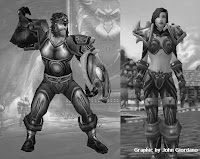In the world of nerd-fandom, women are always considered welcome to take part in the odd, yet intriguing ritual that is convention-going. Visiting these conventions has always been associated with males, for conventions enable the media industry to exhibit the latest in comic books, horror, anime, manga, animation, toys, collectible card games, video games, web-comics, science fiction, fantasy, and pop culture (Reid 4). Though there are females who enjoy their video games, the gaming industry is still seen as a male dominated market. Because of the negative stigma still somewhat attached to those passionate in the aforementioned items, women who display interest are appreciated and encouraged to take part in this new commercial, nerd culture. In other words: being a nerd is cool now.
When I entered the doors of my first convention back in 2006, I was somewhat shocked at the number of women, for the idea I had was that only virginal male troglodytes, such as myself, were expected to attend. After years of appearing at multi-genre conventions, such as Comic-Con International, I-Con, and New York Comic Con, I noticed that females at these events were becoming more numerous and passionate. Actually, this is true, for the most recent Comic-Con in San Diego had around 40% female attendance (Bowles). Considering this particular event attracted an estimated 130,000 individuals, I’d say a crowd of 52,000 women is a respectable amount for a gathering of any kind (Collins). Comic-Con has come a long way since its inception in the mid-1970s, originating as a get together in a hotel showcasing a few comics and some science-fiction oriented artwork attended by a mere few hundred people (Lowry).
There is no one single target audience in these conventions; the beauty of this being that most items found within a convention are gender-neutral and can be enjoyed by anyone. I compare it to surfing the internet, except in reality. One can find any number of items from a wide variety of entertainment, ranging from samurai swords to Pokémon to Buffy the Vampire Slayer. If none of these really pique your interest, many celebrities and artists frequent
these conventions and are eager to greet their fans. Artists are literally lined up in special booths, both male and female; ready to sketch their work for you. Many talented female stars were in attendance at Comic-Con International last year as well, including Mila Kunis, Katie Sagal (voice of Leela in Futarama), Felicia Day, Hayden Panettiere, and Stephenie Meyer (comic-con.com). These conventions can be a bit crowded at peak hours, but literally anyone can visit the ‘con and find something that interests them.
Though their meetings are friendly and social, the nerd culture as a whole still has some work to do regarding gender in the work they produce. Females are appreciated in whole, with great artists and writers dreaming up inspirational and entertaining stories involving strong, independent female protagonists, like Samus Aran from the Metroid series and Captain Kathryn Janeway from Star Trek Voyager. Despite these major leaps forward in terms of how females are portrayed in fiction, female characters are still being used more as non-serious playthings for males to gawk at. In one of the most widely-played video games of all time, World of Warcraft, there is a large difference between how males and females are displayed on-screen.
The Vanguard Armor from World of Warcraft on male avatar (left) as opposed to the female version (right).
Though many female characters are put in places of high regard in the fictional universe, the character avatars still display exaggerated sexual dimorphism. In World of Warcraft (or WoW for short), a player can create an avatar that represents themselves in-game. The male avatars are commonly large and muscular, almost a cliché for a fantasy hero, but the females are almost always scantily clad and petit, whether they like it or not. A piece of armor may look bulky and protective on a male avatar, but that same exact armor piece may mysteriously shrink to bra-size, baring the midriff of a female. This kind of exploitation is common in the gaming world, with the most notable offender being that of the game Bloodrayne, in which the main character, Rayne, is highly sexual in nature, wearing revealing clothing more reminiscent of a dominatrix than a vampire. Unfortunately, female protagonists are often used as devices to target the “horny man” demographic, filling a void where the story lacks in order to sell more games.
Though there is still work to be done to clean up the image of females in the world of fandom, those who follow conventions are eager to befriend anyone who joins in on this quirky subculture. The world of nerds is becoming more female-friendly and hopefully within the next few years, high-attendance conventions may see a fifty-fifty ratio of males to females, with equal entertainment for all who seek it.
Works cited:
“A Look Back on Comic Con 2008.” San Diego Comic-Con. (2008).
Comic-Con International. 9 Apr 2009
con.org/cci2008/index.php>.
Bowles, Scott. “Comic-Con wrap-up: Are superheroes done for?.” USA
Today 28 Jul 2008 Web.12 Apr 2009.
/life/2008-07-27-comic-con-wrapup_N.htm>.
Collins, Sean T.. “San Diego Comic-Con 2008.” All too Flat
28 Jul 2008 Web.9 Apr 2009.
/personal/sean/2008/07/san_diego_comiccon_2008.html>.
Lowry, Brian. “The early days of Comic-Con.” Variety 07 Jul 2008
Web.9 Apr 2009.
/VR1117988845.html?categoryid=1019&cs=1&nid=2562>
Reid, Calvin. “Publishers Find Fans and Trends at Comic-Con.”
Publisher’s Weekly 255(2008): 4. Print.



No comments:
Post a Comment